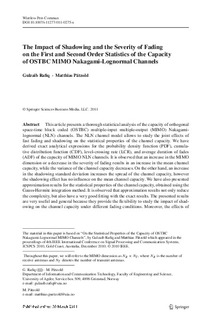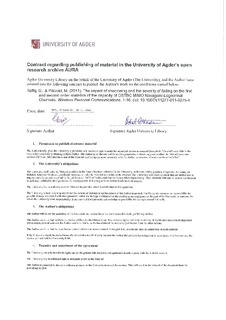| dc.contributor.author | Rafiq, Gulzaib | |
| dc.contributor.author | Pätzold, Matthias | |
| dc.date.accessioned | 2011-10-31T12:03:29Z | |
| dc.date.available | 2011-10-31T12:03:29Z | |
| dc.date.issued | 2011 | |
| dc.identifier.citation | Rafiq, G., & Pätzold, M. (2011). The impact of shadowing and the severity of fading on the first and second order statistics of the capacity of OSTBC MIMO Nakagami-Lognormal Channels. Wireless Personal Communications, 1-16. doi: 10.1007/s11277-011-0275-x | no_NO |
| dc.identifier.issn | 0929-6212 | |
| dc.identifier.uri | http://hdl.handle.net/11250/137932 | |
| dc.description | Published version of an article in Wireless Personal Communications (2011), 1-16. Also available from the publisher at http://dx.doi.org/10.1007/s11277-011-0275-x | no_NO |
| dc.description.abstract | This article presents a thorough statistical analysis of the capacity of orthogonal space-time block coded (OSTBC) multiple-input multiple-output (MIMO) Nakagami- lognormal (NLN) channels. The NLN channel model allows to study the joint effects of fast fading and shadowing on the statistical properties of the channel capacity. We have derived exact analytical expressions for the probability density function (PDF), cumulative distribution function (CDF), level-crossing rate (LCR), and average duration of fades (ADF) of the capacity of MIMO NLN channels. It is observed that an increase in the MIMO dimension or a decrease in the severity of fading results in an increase in the mean channel capacity, while the variance of the channel capacity decreases. On the other hand, an increase in the shadowing standard deviation increases the spread of the channel capacity, however the shadowing effect has no influence on the mean channel capacity. We have also presented approximation results for the statistical properties of the channel capacity, obtained using the Gauss-Hermite integration method. It is observed that approximation results not only reduce the complexity, but also have a very good fitting with the exact results. The presented results are very useful and general because they provide the flexibility to study the impact of shadowing on the channel capacity under different fading conditions. Moreover, the effects of severity of fading on the channel capacity can also be studied. The correctness of theoretical results is confirmed by simulations. | no_NO |
| dc.language.iso | eng | no_NO |
| dc.publisher | Springer | no_NO |
| dc.subject | Average duration of fades, channel capacity, land mobile terrestrial channels, level-crossing rate, Nakagami-lognormal channels, shadowing effects | no_NO |
| dc.title | The impact of shadowing and the severity of fading on the first and second order statistics of the capacity of OSTBC MIMO Nakagami-lognormal channels | no_NO |
| dc.type | Journal article | no_NO |
| dc.type | Peer reviewed | no_NO |
| dc.subject.nsi | VDP::Mathematics and natural science: 400::Information and communication science: 420 | no_NO |
| dc.source.pagenumber | 1-16 | no_NO |
| dc.source.journal | Wireless Personal Communications | no_NO |

